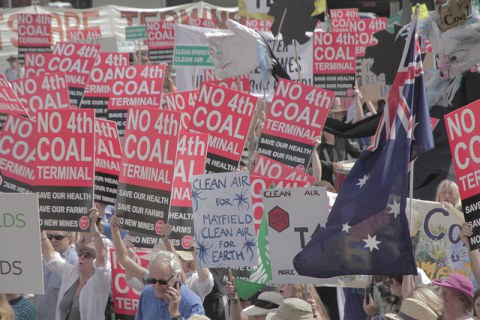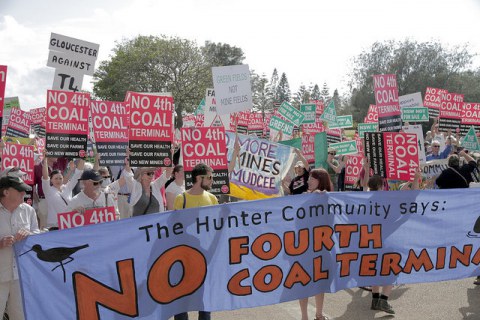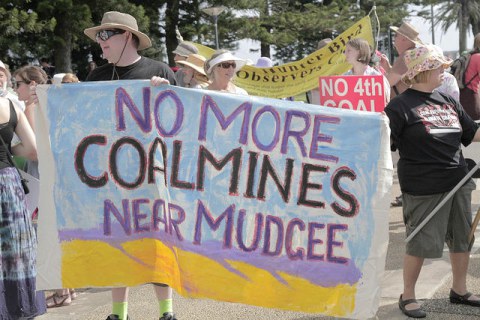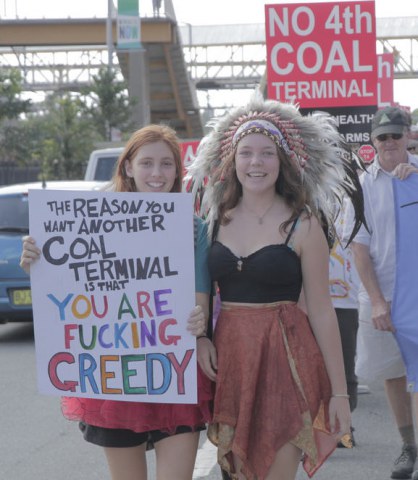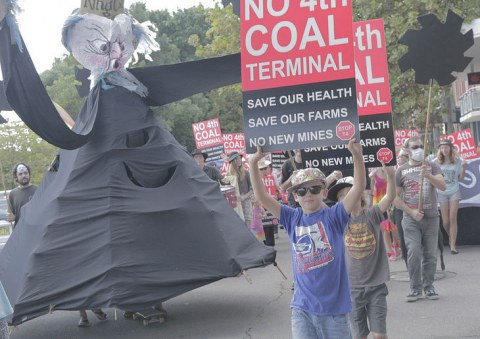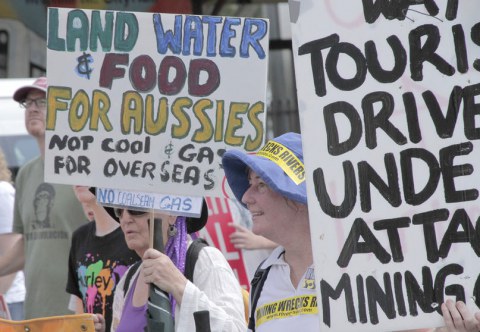Up to 1500 people attended a rally in Newcastle today in opposition to a fourth coal loading terminal being built. Gathering at Customs house at 10am, people marched to Civic Park, chanting 'our water, our health, more precious than your wealth' and 'one two three four, no to T4'. Protestors are concerned with the impact of coal mining on agriculture and water resources, coal dust pollution risks to public health, environmental concerns, and contribution to global climate change.
Related: Photos on Flickr | Youtube Video from Newcastle Herald | Australian based company Ambre Energy pushing coal exports in Oregon

My favourite photo from the protest is a placard saying "The reason you want another coal terminal is that you are fucking Greedy" which perhaps states the obvious...but sometimes the obvious needs to be put in such blunt terms. Already China is indicating it wants to cap it's coal consumption to 4 billion tonnes per year, not much higher than it's current consumption. Much of the recent coal expansion in NSW and Queensland, and the development of other unconventional fossil fuels like CSG, has been driven by the increasing prospect of restrictions placed on fossil fuel extraction due to carbon emissions and the threat of global warming. These companies want to rip as much as they can out to make their profits before community outrage forces them to stop.
The decision by Metgasco to stop exploratory drilling in the Northern Rivers region last week was a massive victory and came after strong community outrage with protests, blockading and numerous arrests during civil disobedience by community members. Much of the community resistance has been co-ordinated by the Lock the Gate Alliance. Another victory was had when the Federal Government announced a water trigger to the EPBC Act as a reform to coal and gas mining and development
And so this Newcastle rally was organised by the Coal Terminal Action Group, an alliance of 17 community groups in Newcastle and the Hunter Valley.
Speakers at the rally at the end of the march included former farmer John Kaye, Brett Holmes from the NSW Nurses and Midwives Association, Associate Professor Nick Higginbotham, Bev Smiles from the Upper Hunter community,
John Kaye said that communities must come before coal and that sustainable planning should look to the long term, not the short term, to preserve arable land and water resources in the Hunter Valley for agriculture rather than allowing massive coal mining development.
Associate Professor Nick Higginbotham said:
"We have concluded that pollution from T4 is a significant threat to public health. Most affected will be 32,000 people living alongside the coal corridor from Newcastle to Rutherford and 23,000 children who live within half a kilometre or attending schools within half a kilometre of the coal rail and the 23,000 residents living close to Kooragang Island.
What we find most objectionable is that the T4 proposal is their denial that any disease burden will be imposed on the residents from noise and pollution.
T4 pollution comes with an unpaid health bill. It's cost will be charged to the victims and their famillies and to all of us who pay for the national health budget. This coal dust bill is not trivial. T4 activities along the rail corridor and coal loader will add 363 tonnes of small particles called PM10 into the air each year. Coal loader expansion will make already poor air quality even worse.
Bev Smiles from the Upper Hunter community described living in the Hunter Valley as like living in a war zone.
"We are fighting for our very survival. From the suburbs of Newcastle, up through Maitland, to Singleton and Musselllbrook and beyond. We are living in a war zone. And the communities, the people, our farming industries, our environment and our rivers are the collateral damage for this coal industry. We're here to say we've had enough, no more, and the fourth coal terminal will not be needed because the ffifteen coal mines being proposed will not go ahead.....Let's reclaim our valley, lets send a strong message to all sides of politics that we are not putting up with any more and this war will be won."
The proposal to build a fourth coal terminal at the port of Newcastle would increase the coal export capacity from 77 million tonnes per annum (Mtpa) in 1997, the current level of 210Mtpa with terminal 3 (T3), to 330 Mtpa with T4.
Approval for the terminal is required from both the NSW State Government for the project to proceed. As the coal terminal is immediately adjacent to a RAMSAR listed wetland, approval is also required from the Federal Environment Minister Tony Burke under the EPBC Act.
Expansion of coal export facilities involves no new jobs. Port Waratah Coal Services stipulate that their existing Kooragang Coal Terminal staff will operate the terminal.
Many health, environment and climate issues have been raised by the community about the expanding coal mining and coal export. Newcastle is the largest coal export port in the world.
The NSW WorkCover agency is investigating the T3 coal loader after an investigation by the University of Newcastle found that workers were up to three times more likely to be diagnosed with cancer than the general population.
The coal terminal is proposed to be built on Kooragang Island and Ash Island which would destroy internationally significant wetlands and bird habitat as listed under the RAMSAR convention. At least 4 migratory shorebird species would be impacted, with 117 different bird species having been observed at the site.
The addition of T4 would result in an additional 40 trains each pulling 90 uncovered coal wagons each day along the rail corridor from the Hunter Valley and Gunnedah Basins into Newcastle. Particulate pollution along this rail corridor already exceeds national standards frequently. There are more than 23,000 students in 60 Hunter schools within 500 metres of the coal rail corridor breathing in air filled with coal dust particulates.
Expansion of coal mining and coal transport is ocurring with little regard to the public health effects. A 2009 study by Singleton GP, Dr Tuan Au, found that of 683 primary and secondary students in the Singleton area examined, one in six had diminished lung function.
Particle pollution regularly exceeds Australian standards. Dr James Whelan from the Hunter Community Environment Centre said "All particle pollution can adversely affect the respiratory and cardiovascular systems and the latest WHO air quality guidelines identify fine particles as one of the most dangerous pollutants for human health,"
Community groups raised $6000 to conduct their own air pollution monitoring up to 400 metres away from the rail corridor as the official assessment done by consultants for the T4 projects only tested within 20 metres of the rail corridor.
The NSW Nurses and Midwives' Association recently backed a call by its Stockton Branch for action to address health issues related to coal dust pollution. Branch president Michael Grant said "These health concerns must be addressed before the New South Wales government approves a new coal terminal for Newcastle."
Greens Senator Lee Rhiannon during the week moved a motion in the Senate drawing attention to coal dust pollution levels regularly exceeding standards imperiling the health of 30,000 people who live within 500 metres of the rail corridor, and called for the NSW Government and Federal Government to reject the T4 project.
Both Labor and Opposition Senators voted against the motion. Senator Rhiannon commented in a media release:
"It is an empty gesture for MPs to furrow their brows and make concerned noises about the health impact on locals if they don't actually act.
"The Greens' motion in the Senate congratulated CTAG and the wider Hunter community for taking action to protect local health and the environment against the impact of coal industry expansion and calls on the NSW and federal governments to reject the T4 project.
"Independent air quality testing showed that Tighes Hill and Carrington had dust pollution levels well in excess of national pollution standards on at least five out of seven days. This is bad news for the thousands of people living, working and going to school up and down the Hunter coal corridor.
"There is no known safe level of exposure to particulate pollution, and international studies have demonstrated direct causal links between particulate pollution and adverse health impacts such as such as asthma and increased risks of cancer.
"When pushed Labor and Coalition MPs will not go on the record as opposing the controversial T4 coal port proposal and continued expansion of coal in the Hunter or stand up against worsening air pollution", said Senator Rhiannon.
The rally and march was organised by the Coal Terminal Action Group, an alliance of 17 community groups: Barrington Gloucester Stroud Preservation Alliance; Climate Action Newcastle; Correct Planning and Consultation for Mayfield Group; Gloucester Residents in Partnership; Green Corridor Coalition; Hunter Bird Observers Club; Hunter Communities Network; Hunter Community Environment Centre; Hunter Environment Lobby; National Parks Association Hunter Branch; Parks and Playground Movement; Rising Tide Newcastle; Singleton Healthy Environment Group; Stockton Community Action Group; Nature Conservation Council; The Wilderness Society; and Tighes Hill Community Group.
Sources:
- Hunter Community Environment Centre, December 2012 - Fact sheet on T4
- NSW Nurses Association news, 5 March 2013 - Alarm over coal dust
- NSW Nurses Association news, 5 March 2013 - Worry in the Playground
- Newcastle Greens, 11 March 2013 - Hunter air quality crisis: health tests of children required
- Senator Lee Rhiannon media release, 14 March 2013 - Major parties ignore Hunter coal health impacts: vote down T4 motion
- Photos by Lucy Alcorn / Coal Mine Action Group - Rally to Stop T4, Newcastle used with permission via Kate Ausburn
